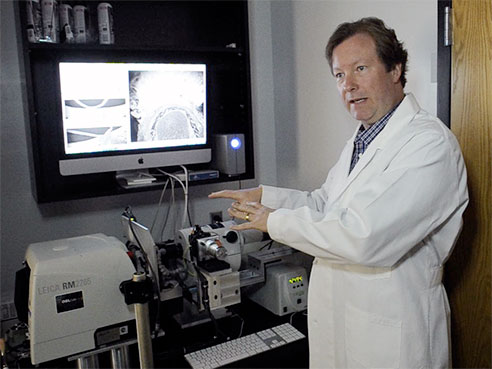 J. Crawford Downs, Ph.D., has received a four-year, $1.88 million grant from the National Eye Institute to further explore the underlying mechanisms of glaucoma and bring the relationship between age, intraocular pressure and glaucoma development into focus. This award is in addition to a three-year, $1.23 million grant Downs received in May 2015 to investigate the role of intraocular pressure fluctuations in glaucoma.
J. Crawford Downs, Ph.D., has received a four-year, $1.88 million grant from the National Eye Institute to further explore the underlying mechanisms of glaucoma and bring the relationship between age, intraocular pressure and glaucoma development into focus. This award is in addition to a three-year, $1.23 million grant Downs received in May 2015 to investigate the role of intraocular pressure fluctuations in glaucoma.People more than 60 years of age are six times more likely to develop glaucoma, which can result in irreversible blindness when left untreated. As the U.S. population ages, the number of glaucoma cases will also increase, and it is projected that more than 5.5 million Americans will suffer from glaucoma by 2050.
“Aging is an important risk factor for glaucoma, but we still don’t understand why the disease preferentially impacts the elderly,” Downs said. “This additional grant will allow us to explore glaucoma development and progression in both young and old cohorts so we can determine age-related differences in intraocular pressure fluctuations and other biomechanical risk factors. Once we understand why age is a risk factor, we can begin to develop targeted treatments.”
In addition, Downs will also be able to test hypotheses related to another emerging risk factor for glaucoma, low ocular perfusion pressure.
“The eye is a pressurized vessel, and it must be properly inflated to keep its round shape and function properly,” he said. “We know increased intraocular pressure can lead to damage of the optic nerve associated with glaucoma and vision loss.”
Downs says there also appears to be a relationship between decreased blood perfusion pressure into the eye, called ocular perfusion pressure, and glaucomatous damage to the optic nerve.
“Basically, we need to understand what levels of both intraocular and ocular perfusion pressure increase glaucoma risk and why, and whether fluctuations in these pressures are important in the disease process,” he said.
Downs is director of the UAB Ocular Biomechanics and Biotransport Program, which aims to further understand the eye by applying traditional engineering principles to diseases such as glaucoma, myopia and keratoconus. This group has already made several notable discoveries including using radiotelemetry to demonstrate that intraocular pressure is much more dynamic than previously appreciated.
“Biomechanics shows great promise for filling critical knowledge gaps about eye disease,” Downs said. “I am especially grateful for UAB’s support of this emerging field, as well as the philanthropic support from the EyeSight Foundation of Alabama that made it possible to collect the pilot data needed to secure this funding. I believe our work will advance our understanding of blinding eye diseases and inform new treatment methods.”